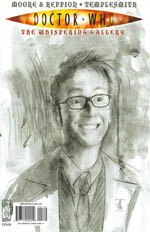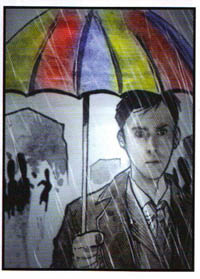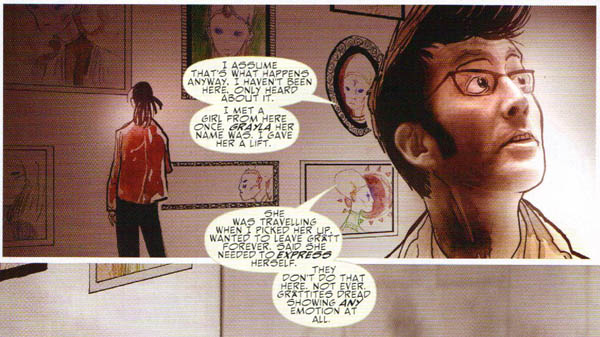 Written by Leah Moore and John Reppion
Written by Leah Moore and John Reppion
Art by Ben Templesmith
32 pages, color
Published by IDW
There’s no two ways about it, I love me some good Doctor Who. The problem can be, like with just about all licensed comics, actually getting just that. It’s a very difficult process to get both the writing and the art to not only mirror the original property that you’re supposed to be about, but also still feel fresh and different. It’s with all of this in mind that I felt like I had to take a look at Doctor Who: The Whispering Gallery, because if there was one creator whose work I wouldn’t have immediately pegged for this sort of project, it’s artist Ben Templesmith.
 The Doctor and Martha have landed on Gratt, a planet where their Whispering Gallery contains the paintings of the deceased. More importantly, though, these paintings also contain the final words of those who have passed on. When the Doctor discovers a former friend’s portrait in the gallery, though, he has to act—and that’s when he discovers that emotion is banned entirely on Gratt.
The Doctor and Martha have landed on Gratt, a planet where their Whispering Gallery contains the paintings of the deceased. More importantly, though, these paintings also contain the final words of those who have passed on. When the Doctor discovers a former friend’s portrait in the gallery, though, he has to act—and that’s when he discovers that emotion is banned entirely on Gratt.
I have to say, I was really pleasantly surprised with how well Ben Templesmith’s art worked in Doctor Who: The Whispering Gallery. His art is so stylized and distinct that I—quite erroneously—assumed that it wouldn’t fit into a comic that would have to fit likeness restrictions of actors. What impressed me from the cover onwards is how well Templesmith is able to not only make the characters look like they do on the television, but at the same time still end up clearly in his own beautiful art style. The Doctor’s face is spot on as David Tennant, not only physically but also how Tennant has become so expressive in the role. From his curiosity poking around in the Whispering Gallery, to his sadness as he walks alone in Gratt after discovering his friend’s death, you can look at the comic and say, "Yep, that’s him." But even though he and Martha both look like they do on the show, Templesmith is able to add in his own flair, from slight stretching of anatomy, to the almost squiggle-like hair and backgrounds around them. Best of all is how well Templesmith works with color, here; the scene of the Doctor in the rain with his old colorful umbrella is just spot-on, the colors popping out in an otherwise bleak tableau, but almost as if they’re about to start running in the weather like watercolors. It’s a gorgeous, gorgeous book and I’d love to see Templesmith tackle a longer project down the line for the Doctor Who line.

What I wasn’t as crazy about, though, was Leah Moore and John Reppion’s script. Neither the Doctor nor Martha actually "sound" like their counterparts from the show. The Doctor is a little too callous and ignoring, while Martha comes off surprisingly weak-willed and spoon fed by the Doctor.  At first it felt like the story was written for a generic Doctor and companion pairing (which the Doctor and Martha certainly were not—I think it’s safe to say that all four series of the new show have shied away from generic Doctor/companion roles), but the more I read it, the more it actually felt like it was supposed to be the 6th Doctor and Peri pairing from the mid-80s, and once you see it that way it makes it feel all the stranger and out of place.
At first it felt like the story was written for a generic Doctor and companion pairing (which the Doctor and Martha certainly were not—I think it’s safe to say that all four series of the new show have shied away from generic Doctor/companion roles), but the more I read it, the more it actually felt like it was supposed to be the 6th Doctor and Peri pairing from the mid-80s, and once you see it that way it makes it feel all the stranger and out of place.
The story itself isn’t bad, but also deserving of more than a one-shot. The Doctor’s defeat of the lurking menace on Gratt is a little too rushed, and Martha’s subplot begs for some expansion, feeling a little too pat and predictable. There’s a really interesting idea buried in her re-arranging of the Gallery, but in the end it feels almost brushed aside and forgotten in favor of a big monster roaring overhead. Even the titular Whispering Gallery deserves a little more attention than it gets; it’s a good concept, but it doesn’t seem to get the proper exploration that such a setting could provide.
Doctor Who: The Whispering Gallery isn’t bad by any stretch of the imagination, but its only real selling point is Templesmith’s art. The writing just never clicks in more ways than one, and to be fair it’s a hard task to tackle. Maybe if Moore and Reppion had a little more space they’d be able to ease into this story, but for now it’s just not quite there. Still, Templesmith’s interpretations of the characters look so beautiful, it’s hard to simply ignore this one-shot comic.
